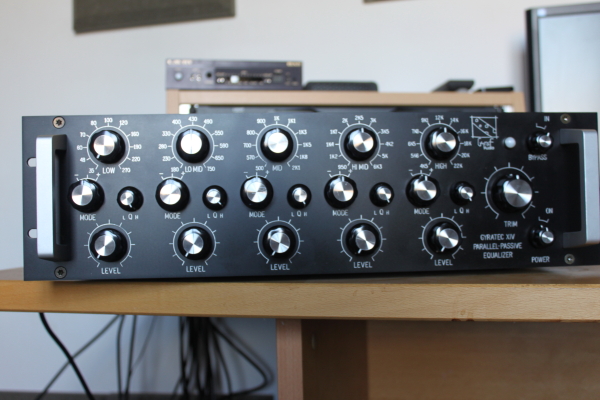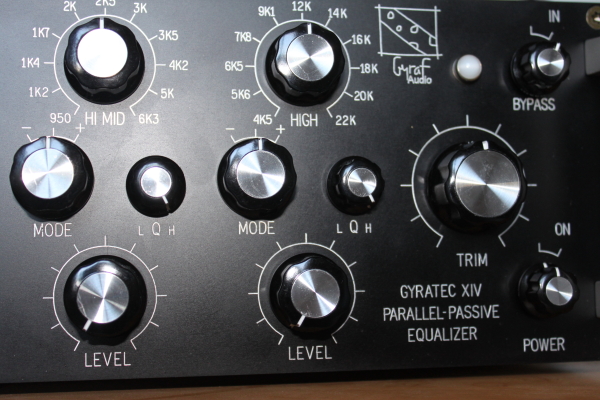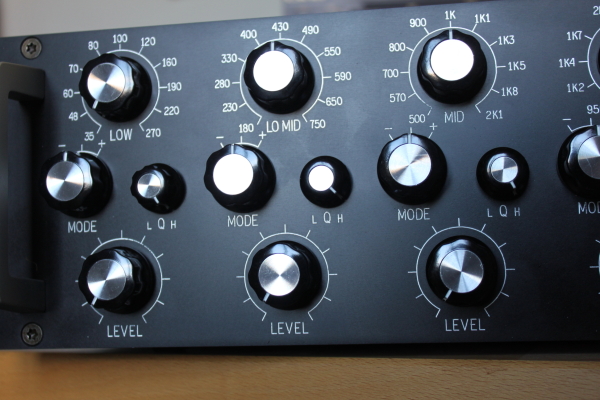New Mastering Eq |
|
|
|
|
|
| Nov 12 2011, 01:41 PM |
|
I posted a while back that we had ordered a new mastering EQ for the studio. Well it's now arrived so here's a few pictures of it and some information:
It's a Gyraf Gyratec XIV mastering EQ. Gyraf are a small run manufacturer in Denmark who only do hand built, tube based mastering equpiment. Gyraf have been in business for quite a few years and are very well thought of. Here's a review of the XIV in Resolution. (Resolution is kind of the de facto pro audio engineers trade mag.). It is a passive, all tube, parallel design and has five stereo EQ bands. It's only available in black and takes up 3 unit spaces in a full width rack.  Passive means that it needs to run have it's output passed to an external amp to boost the signal gain. So ours runs to a separate amp (a DAV Electronics BG) for this and from there to the rest of the audio chain. Why use a passive instead of a more standard active EQ? Passive is much better at preserving the stereo width of a recording: actives tend to narrow it and so you end up with a much smaller stereo field. It also means that the EQ itself is quieter as it can be properly screened internally from the amp and so you have less cross talk and distortion of the signal path. As an all tube design it means that just like an all tube guitar amp it's valve based and so also has that elusive valve warmth and produces nice harmonic order distortion: the kind that sounds nice rather than nasty. One of the things we get asked a lot is to try and get a digital recording to sound more analogue and so a tube based hardware will help a lot here. This is the sort of thing that you really can't get in a vst emulation of hardware. (If we need to stay totally clean we can bypass the Gyraf and just use our hardware Sontec EQ.) It's a parallel EQ. Now the vast majoirty of EQs are serial and that means that each EQ band is passed one after the other, in order, through the remaining bands. It's as if they are all in a straight line and to get to band 4 you have to go through1, 2 and 3 first and then also through 5 finally. What that means is that if any thing you do on band 4 is also affected by anything you do on all the other bands. This becomes a potential issue in mastering because bands that are close to each other can end up significantly affecting the one you want to adjust. In a serial design if you want to cut band 2 at 200Hz and boost at 250 on band 3 then it's difficult to achieve intentionally: the amount you cut on 2 also prodcues a cut on band 3 and so you end up having to boost much more then you think. In a parallel design all the bands are separate so if you only adjust band 4 the signal doesn't pass through 1,2,3 and 5 before it gets to the summing. That means if you make an adjustment say at 200 Hz on band 2 and at 250Hz on band 3 they don't interact and affect each other in an unintended way.  It's a stereo 5 band bell curve EQ. There are no HPF and LPF or shelves here - we use a Sontec to do this. The bands cover a range from 35Hz upto 22kHz. The actual bands are 35-270 Hz, 180-&50 Hz, 500-2kHz, 950-6kHz and 4k-22kHz and each band has 11, stepped, detented positions. Stepped detented here means its not fully sweepbale between say 180-750Hz on band 2: there are 11 selectable frequencies in that range that you can chose. This means that any frequency adjustment is both accurate and can be properly recalled and repeated. Bands overlap but focus on key frequency ranges so there is a lot of versatilty but also a lot of useability. Each band can be set to attenuate or apply gain to the eq. This is adjustable from 0-12dB, with the actual amount being dependent on the width of the 'Q' and the actual frequency adjusted. 'Q' is also bigger/sharper in cut/attenuation. In mastering a lot of EQ work tends to fall in to two distinct areas: surgical and colour. Surgical means you're trying to affect and control a specific frequency and that nearly always means you're trying to cut or reduce a band. You need a very sharp 'Q@ to do this with accuracy. Colour however often means you trying to add a small amount of gain to a particular range to bring it out a bit (i.e. to add some air to a recording). This is nearly always done on a wide 'Q' as you need to adjust a range on related frequencies in order for the result to sound musical.  So there you have it, our new mastering EQ. Price (not including an amp that you'll need to get as well.) is about $6000. -------------------- Get your music professionally mastered by anl AES registered Mastering Engineer. Contact me for Audio Mastering Services and Advice and visit our website www.miromastering.com
Be friends on facebook with us here. We use professional, mastering grade hardware in our mastering studo. Our hardware includes: Cranesong Avocet II Monitor Controller, Dangerous Music Liasion Insert Hardware Router, ATC SCM Pro Monitors, Lavry Black DA11, Prism Orpheus ADC/DAC, Gyratec Gyraf XIV Parallel Passive Mastering EQ, Great River MAQ 2NV Mastering EQ, Kush Clariphonic Parallel EQ Shelf, Maselec MLA-2 Mastering Compressor, API 2500 Mastering Compressor, Eventide Eclipse Reverb/Echo. |
|
|
||
|
|
|
|
|
Nov 12 2011, 07:55 PM
|
|
I posted a while back that we had ordered a new mastering EQ for the studio. Well it's now arrived so here's a few pictures of it and some information: It's a Gyraf Gyratec XIV mastering EQ. Gyraf are a small run manufacturer in Denmark who only do hand built, tube based mastering equpiment. Gyraf have been in business for quite a few years and are very well thought of. Here's a review of the XIV in Resolution. (Resolution is kind of the de facto pro audio engineers trade mag.). It is a passive, all tube, parallel design and has five stereo EQ bands. It's only available in black and takes up 3 unit spaces in a full width rack.  Passive means that it needs to run have it's output passed to an external amp to boost the signal gain. So ours runs to a separate amp (a DAV Electronics BG) for this and from there to the rest of the audio chain. Why use a passive instead of a more standard active EQ? Passive is much better at preserving the stereo width of a recording: actives tend to narrow it and so you end up with a much smaller stereo field. It also means that the EQ itself is quieter as it can be properly screened internally from the amp and so you have less cross talk and distortion of the signal path. As an all tube design it means that just like an all tube guitar amp it's valve based and so also has that elusive valve warmth and produces nice harmonic order distortion: the kind that sounds nice rather than nasty. One of the things we get asked a lot is to try and get a digital recording to sound more analogue and so a tube based hardware will help a lot here. This is the sort of thing that you really can't get in a vst emulation of hardware. (If we need to stay totally clean we can bypass the Gyraf and just use our hardware Sontec EQ.) It's a parallel EQ. Now the vast majoirty of EQs are serial and that means that each EQ band is passed one after the other, in order, through the remaining bands. It's as if they are all in a straight line and to get to band 4 you have to go through1, 2 and 3 first and then also through 5 finally. What that means is that if any thing you do on band 4 is also affected by anything you do on all the other bands. This becomes a potential issue in mastering because bands that are close to each other can end up significantly affecting the one you want to adjust. In a serial design if you want to cut band 2 at 200Hz and boost at 250 on band 3 then it's difficult to achieve intentionally: the amount you cut on 2 also prodcues a cut on band 3 and so you end up having to boost much more then you think. In a parallel design all the bands are separate so if you only adjust band 4 the signal doesn't pass through 1,2,3 and 5 before it gets to the summing. That means if you make an adjustment say at 200 Hz on band 2 and at 250Hz on band 3 they don't interact and affect each other in an unintended way.  It's a stereo 5 band bell curve EQ. There are no HPF and LPF or shelves here - we use a Sontec to do this. The bands cover a range from 35Hz upto 22kHz. The actual bands are 35-270 Hz, 180-&50 Hz, 500-2kHz, 950-6kHz and 4k-22kHz and each band has 11, stepped, detented positions. Stepped detented here means its not fully sweepbale between say 180-750Hz on band 2: there are 11 selectable frequencies in that range that you can chose. This means that any frequency adjustment is both accurate and can be properly recalled and repeated. Bands overlap but focus on key frequency ranges so there is a lot of versatilty but also a lot of useability. Each band can be set to attenuate or apply gain to the eq. This is adjustable from 0-12dB, with the actual amount being dependent on the width of the 'Q' and the actual frequency adjusted. 'Q' is also bigger/sharper in cut/attenuation. In mastering a lot of EQ work tends to fall in to two distinct areas: surgical and colour. Surgical means you're trying to affect and control a specific frequency and that nearly always means you're trying to cut or reduce a band. You need a very sharp 'Q@ to do this with accuracy. Colour however often means you trying to add a small amount of gain to a particular range to bring it out a bit (i.e. to add some air to a recording). This is nearly always done on a wide 'Q' as you need to adjust a range on related frequencies in order for the result to sound musical.  So there you have it, our new mastering EQ. Price (not including an amp that you'll need to get as well.) is about $6000. Man , I love all info you give us, but I still can't get cubase to install on my computer without it causing various script errors So hopefully one day I can start learning to un derstand all this |
|
|
||
|
|
|
|
| Nov 12 2011, 08:44 PM |
|
Wow, that's an impressive unit no doubt!
-------------------- - Ivan's Video Chat Lesson Notes HERE
- Check out my GMC Profile and Lessons - (Please subscribe to my) YouTube Official Channel - Let's be connected through ! Facebook! :) |
|
|
||
1 User(s) are reading this topic (1 Guests and 0 Anonymous Users)
0 Members:






















